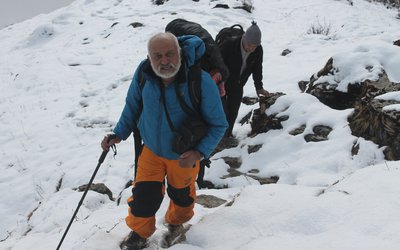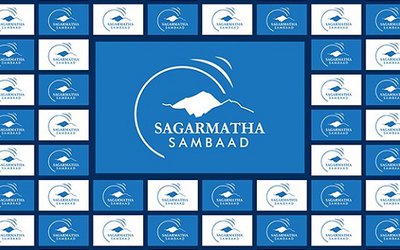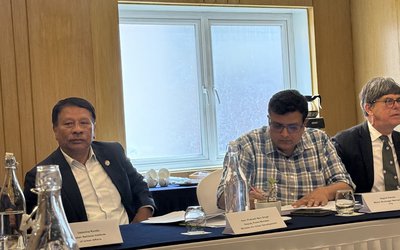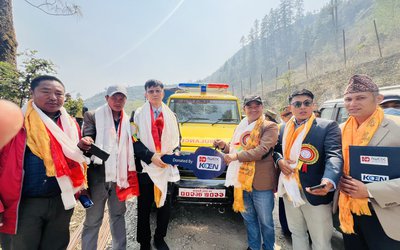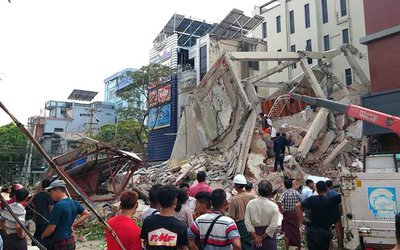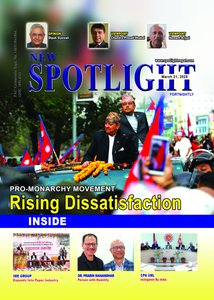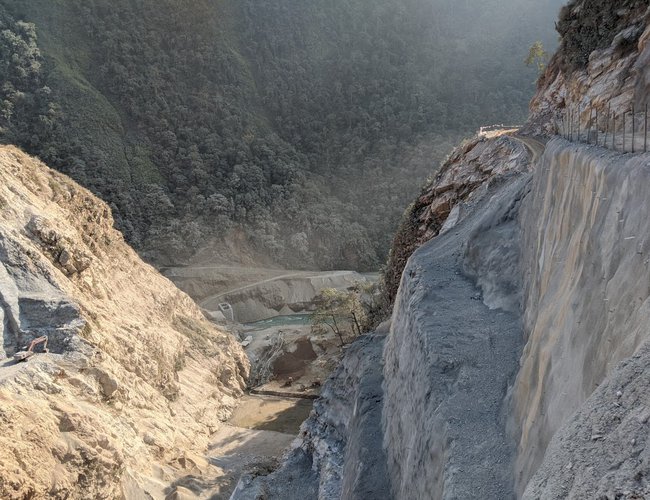
The competent government authority for the approval of the Environmental Impact Assessment (EIA) reports of all sectors in any geographical areas - the Ministry of Forests and Environment (MoFE) - has enjoyed in approving EIA reports and regulating EIA process since the last 7 years as the government established MoFE. Some of the officers working in the Environmental Assessment Section of the then Ministry of Population and Environment are engaged in reviewing and approving processes of the EIA and its associated reports.MoFE is legally empowered to approve the EIA reports and provide forests and/or conservation areas for the construction and operation of the proposed project. As the same ministry has these two roles, once the EIA report is legally approved it is most likely that the project proposed for construction and operation in the forests and watersheds, and conservation and protected areas gets proposed land area and resources of such areas. On 9 August 2024, UML Secretary-General Mr. Shankar Pokhrel said that there is no need for a plan to increase forest area in Nepal (https://deshsanchar.com/2024/08/09/946303/). This indicates the possible use more forest areas and additional environmental disasters from likely deforestation and forest degradation.
As per the Environment Protection Act (EPA, 2019) and the Environment Protection Rules (EPA, 2020), MoFE is empowered to approve project-specific scoping document (SD), terms of reference (ToR) and the EIA reports. In principle, SD outlines priority issues that must be considered during EIA report preparation, and ToR provides guidance to the proponent to identify, predict and evaluate impacts of the project activities on the environment.
As understood from the last four-and-half decades, EIA report is multi-stakeholder owned. Although the project proponent prepares it, project beneficiaries and affected communities are well informed about the benefits and adverse impacts of the project on the environment, people and resources and proposed measures to enhance beneficial and mitigate the adverse impacts. Concerned ministries and departments are fully engaged in reviewing the SD, ToR, and the EIA report while MoFE ensures review and compliance with the legal provision and approves the EIA and its associated reports.
On 11 July 2024, MoFE made the EIA report of the 45 MW ChumchetSyarkhola Hydroelectric Project (CSHEP) public to collect multi-stakeholders' suggestions. The Chilime Hydropower Company Ltd., the proponent of this CSHEP, has planned to construct and operate this project within the Manaslu Conservation Area (MCA), Gorkha, and prepared this EIA report to comply with the provisions of Schedule 3 of the EPR (2020) and the approved ToR.
The EIA team conducted the field study between BS 2080/06/16 and BS 2080/06/29. The proponent organised a public hearing on BS 2080/06/19 in Chumnubri Rural Municipality (CRM) - 6 and collected the recommendation letters from CRM on BS 2080/07/03 and from MCA liaison office on BS 2080/09/29 to comply with the legal provisions. The EIA report uploaded in MoFE's website to collect suggestions confirms that the EIA report was discussed with the MCA officials before collecting the recommendation letter. It also confirms public hearing in the project site, and recommendation letter of the CRM.
Review of the EIA report of this HEP raises concerns and urges the competent authority to reconsider the basics of introducing public hearing and need for recommendation letters as legal requirements.
In mid-1990s, EIA was clearly understood as a planning and predictive tool that identifies and predicts the impacts of the project on the environment (physical, chemical, biological, social, economic and cultural domains) and evaluates the significance of the identified and predicted impacts. In the EPA (1996) and EPR (1997), repealed by the EPA (2019) and EPR (2020), the provision on public hearing was made legally mandatory to inform the project affected people and multi-stakeholders, along with the competent authorities, about the beneficial and adverse impacts of the project activities along with the corresponding benefits enhancement and adverse impacts mitigation measures, a plan for the implementation of proposed measures, monitoring and auditing. It means, public hearing should be conducted at the project site once the draft EIA report is ready for sharing. This was well practiced. Based on the inputs received from the public hearing, the draft EIA report wasfinalised and sent to the concerned local level (municipality or the rural municipality) for a recommendation letter. The municipality was considered the 'guardian' of the project affected people and local resources and should confirm the inclusion of appropriate concerns raised during the public hearing and issue the recommendation letter(s). However, the present legal regime undermines it and considers organising 'public hearing' anytime is valid, and 'recommendation letters' before draft report preparation is also valid. The present practice on public hearing provides concerns, issues, views and demands which were previously included in the scoping document. Recommendation letters include concerns and demands.
In general, the EIA report of this CSHEP attempts to comply with the approved ToR, and report quality is considered improved. The EIA team has made its effort to make a comprehensive report with lots of information which are neither used to identify, predict and evaluate the significance of impacts nor to propose enhancement and mitigation measures and/or environmental monitoring and auditing. The team has analysed flood and sediment load, landslides susceptibility, and seismic intensity and assessed GLOF risks unlike previous EIA reports. Alternative analysis has adopted sequential approach to select most appropriate alternative. However, EIA report does not clarify beneficial and adverse impacts and a plan for measures implementation, monitoring and auditing of only the selected alternative.
Several impacts are qualified. Policies, laws and guidelines which are not directly related to the project and its location are reviewed and some mitigation measures proposed are difficult to relate with project-induced impacts. Linkage of project site with wildlife 'core habitat' is unclear but cost estimate for wildlife welfare and treatment centres and an ambulance deserves special attention. Review of EIA report of this CS HEP raises several issues. Only few issues are given below as an example:
- The issued ToR simply recognised the need for 'prediction and analysis' and focused on 'effects'. In general understanding, EIA being the predictive tool should focus on 'impact' and 'identification and prediction of impacts' and significance evaluation of both 'identified and predicted impacts'.
- Conservation area is understood a legally designated area for the conservation of natural environment and balanced utilisation of natural resources and is managed through an integrated plan. This HEP is proposed for construction and operation within MCA by using its 21.08 ha. Change in locations of the weir, intake, tunnel inlet and outlet, access road etc. may affect to optimise project's installed capacity but there is a possibility to manage the muck, operate the worker's camp, and collect and store construction materials outside the MCA. If such activities are implemented outside the MCA, land use of over 12 ha of the MCA will not be changed.
- Collection and storage of construction materials and implementation of a quarry plan should be a part of the project than environmental measures. It calls for clarity on project activities and environmental impacts, and separate costs for project activities and environmental measures.
- Adoption of a total score of magnitude, extent and duration of impact to evaluate the impact significance does not provide a realistic outcome. Significance should also consider the nature of impact (direct or indirect). Site-specific and construction-related impacts 'will occur' but will be rated 'low significance' by adopting such a 'blanket' approach.
- The EIA report mentions several types of environmental auditing but does not specify the type of auditing that should be conducted for this project.
- The approved ToR instructs to study breeding potential of endangered species of fish, crocodile and dolphin and other aquatic life with a view to promote species conservation and tourism. The EIA report mentions no fish species and fisherman within the project site. It calls for being realistic while approving the ToR.
- The practice of providing recommendation letters with lots of conditions needs rectification. The MCA in its recommendation letter mentions, inter alia, adoption of upstream-downstream impacts mitigation measures, and inclusion of 'payment for environmental services'. Who ensures inclusion of such conditions in the EIA report and their implementation is unclear.
- Ownership of the EIA report must be with the proponent. Consultants should be considered only the 'technical arm' of the proponent to prepare the EIA report, if involved.
The EIA team has provided a clear picture of environmental investment for this HEP. This environmental cost includes estimated budget for the implementation of enhancement and mitigation measures, environmental monitoring and auditing. Environmental cost is estimated at 0.521 percent of the total project cost. In addition, EIA report commits 0.75 percent of the total project cost for community support programmes. The former cost is for therestoration and/or mitigation of project-induced environmental damages and enhancement of benefits, and later is purely a support to the local communities which might or might not be related to environmental safeguards. Hence, budget estimation for environmental improvement programmes is only NRs 50 paisa of each NRs 100 spent for the project construction and operation. This cost would be even low if project-relatedactivities, mentioned above, and environmental measures are clearly separated.
In many projects, Nepal's EIA reports have estimated cost for environmental enhancement and mitigation measures, including monitoring and auditing at the range of 0.5 to 2.5 percent of the total project cost to offset environmental damages. Taking note of nearly 3 decades of Nepal's involvement in preparing and approving EIA reports legally, timely amendmentof the EPR (2020) would facilitate to make the development projects environment-friendly and sustainable - the main purpose of the EIA tool - by rectifyingexisting complications, separating project-related activities and project-induced environmental impacts, and making EIAs project-specific, cost-effective and implementable.

Batu Uprety
Former Joint-Secretary and Chief of Climate Change Management Division, Ministry of Environment (then), and former Team Leader, National Adaptation Plan (NAP) formulation process. E-mail: upretybk@gmail.com
- Sagarmatha Sambad: Likely Bearing the Fruits
- Mar 27, 2025
- Decadal Experience In Preparing The NDC
- Mar 03, 2025
- Over Five Decades Of Concern On Air Pollution
- Jan 16, 2025
- Damaging The Functional EIA Track
- Dec 22, 2024
- Baku CoP29 Outcomes And Nepal's Initiatives
- Nov 26, 2024

